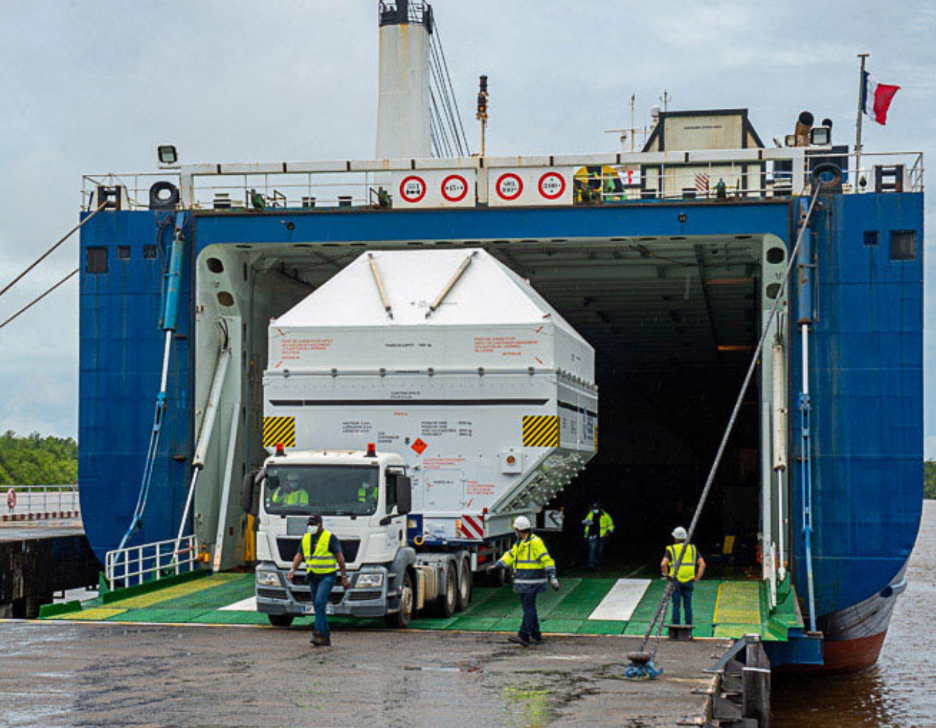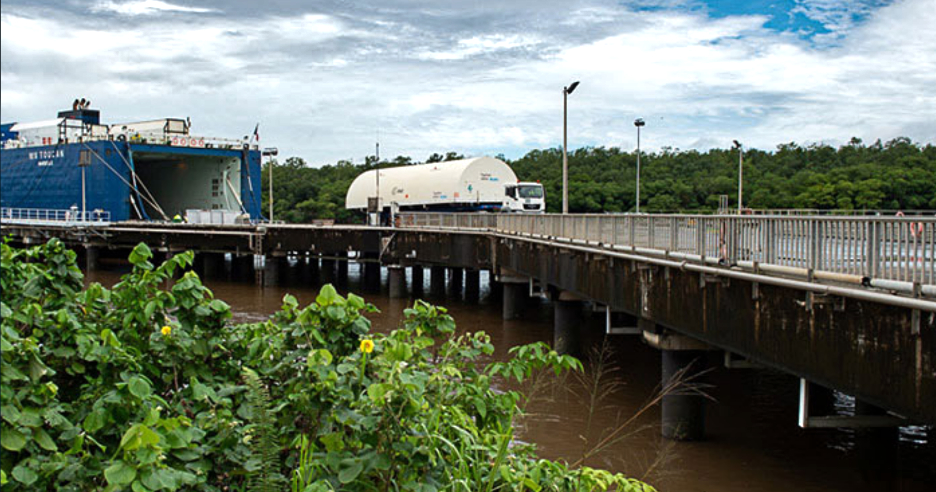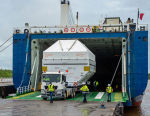
A pair of important arrivals this week – one by air, the other by sea – marked an acceleration of preparations at Europe’s Spaceport for Arianespace’s next two missions, to be performed from French Guiana with its lightweight Vega and heavy-lift Ariane 5 launch vehicles.
These parallel arrivals involved personnel who will conduct the first Vega “rideshare” mission, scheduled for mid-June to orbit 53 small satellite payloads; and Ariane 5 launch vehicle components for a three-passenger flight planned for liftoff this summer.
Team members for the Vega launch campaign were flown in aboard a chartered airliner that touched down at Félix Eboué Airport near the French Guiana capital city of Cayenne. They will be responsible for preparing this mission’s liftoff from the Vega Launch Complex (ZLV), located on the Kourou side of the Spaceport.
As the personnel were settling in, main launcher components for the Ariane 5 flight were being unloaded from the MN Toucan, one of two roll-on/roll-off sea-going ships operated for Arianespace, which docked at Paricabo Port near Kourou. After unloading, the components were to be taken by road to the Ariane 5’s ELA-3 launch complex – also situated on the Spaceport’s Kourou side.
Launch activities in French Guiana had been suspended mid-March because of the COVID-19 pandemic, and were gradually resumed – carried out in strict compliance with health rules published by the Prefect of French Guiana, as well as the French CNES space agency and the Guiana Space Center.
Vega proof-of-concept flight for SSMS
Designated Flight VV16 in Arianespace’s numbering system, Vega’s mission will be the first of the Small Spacecraft Mission Service (SSMS) – a program initiated by the European Space Agency (ESA) in 2016, with the contribution of the European Commission. For all the European partners involved, its purpose is to perfectly address the burgeoning microsatellite market for institutional and commercial customers alike.
The modular SSMS dispenser was designed to be as market-responsive as possible, able to accommodate a wide combination of payloads – from a main large satellite with smaller companions to multiple smaller satellites, or dozens of individual CubeSats.
Flight VV16 will be Arianespace’s fifth launch overall in 2020, and its first this year using the lightweight Vega member of its launch vehicle family – which also includes the heavy-lift Ariane 5 and medium-lift Soyuz.
The satellite passengers on Flight VV16 will be deployed by Vega to Sun-synchronous orbits. They will serve different types of applications, such as Earth observation, telecommunications, science and technology/education.
Readying Ariane 5’s three-satellite payload
For Arianespace’s initial Ariane 5 mission following the resumption of operational activity at the Spaceport, its heavy-lift launcher will carry three payloads to geostationary transfer orbit: the Galaxy 30 and BSAT-4b telecommunications satellites, along with a Mission Extension Vehicle (MEV).
Riding in Ariane 5’s upper payload position will be Galaxy 30, produced by Northrop Grumman Innovation Systems (NGIS). This is the first spacecraft built under Intelsat’s North American satellite fleet replacement program and highlights the operator’s continued focus on C-band communication technologies.
To be deployed as a Galaxy 30 “piggyback” payload is Northrop Grumman’s second Mission Extension Vehicle (MEV-2) – a servicing spacecraft that docks with an existing satellite in orbit to provide life-prolonging propulsion and attitude control. After deployment by Ariane 5, MEV-2 will service the Intelsat 10-02 satellite, which was launched in 2004.
Flight VA253’s other passenger on Ariane 5 – BSAT-4b – was built by Maxar Technologies for Japan’s Broadcasting Satellite System Corporation (B-SAT) as a back-up to BSAT-4a, launched by Arianespace in 2017. BSAT-4b uses Maxar Technologies’ 1300 Class platform and carries Ku-band transponders.


